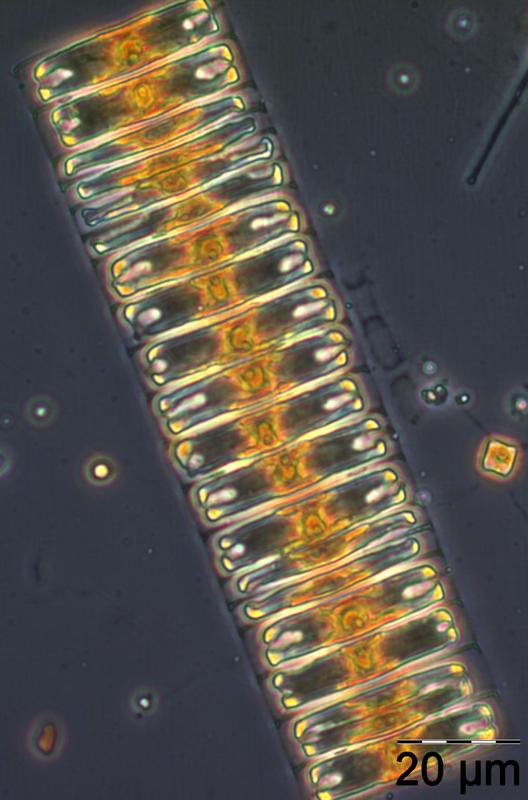A new indicator for marine ecosystem changes: the diatom/dinoflagellate index

Diatom Achnanthes taeniata IOW
The European Union declared it their target to re-establish a „good ecological status“ in European seas by 2020. Quite a challenging task! But what actually is a good ecological status?
Like of us humans, the „state of health“ of an ecosystem cannot be defined by one single factor only. It is important to take all basic functions into account. Therefore, in total eleven so called descriptors were defined. „Eutrophication“ is such a descriptor to describe the state of the ecosystem, „food web stability“ another.
The quality of the food web in the Baltic Sea and how it can be determined is subject of two articles by Norbert Wasmund, phytoplanktologist at the Leibniz Institute for Baltic Sea Research Warnemünde, recently published in the international open access journal „Frontiers in Marine Science“. He describes a new indicator basing on relatively simple measurements and simultaneously applicable as an indicator for eutrophication: the diatoms/dinoflagellates index – in short: the dia/dino index.
Once the days get longer in spring, the seas and oceans experience the so called spring bloom: microalgae use the energy of the sun light in order to build up organic substances by means of basic elements as carbon, nitrogen and phosphorus. In the course of a few days to weeks, the microorganisms reproduce themselves very rapidly.
In the Baltic Sea, these organisms mainly belong to the groups of diatoms and dinoflagellates. They are essentially responsible for the foundation of a food pyramid upon which nearly all other forms of marine life depend and on the top of which marine mammals and human beings are positioned. The dia/dino index describes which of the two groups dominated the yearly spring bloom. This in turn is decisive for organisms preying them: Diatoms with a relatively heavy silica shell sink to the seafloor immediately after their death.
Thus, beside the zooplankton preying them in the surface waters, the zoobenthos at the seafloor, too, benefits from this food source. Dinoflagellates are lighter and do not sink to the seafloor after their death in such a rapid way as the diatoms do. In the consequence, zooplankton can benefit from them for a longer time, but nearly nothing is left to feed the zoobenthos. Norbert Wasmund explains: “If diatoms dominate the spring bloom, more parts of the food web take profit than if dinoflagellates are the major group. So, this simple relation provides us with a good measure to describe the state of the food web“.
As a benchmark for a good ecological status in the Baltic Sea serve the environmental conditions in the first half of the 20th century. Fortunately, we can already rely on observational data from this time, when the environmental damage can be regarded as negligible.
Phytoplankton data from the Baltic Sea exist since the beginning of the 20th century. Therefore, calculating the respective historical status of the dia/dino index is possible. Norbert Wasmund summarizes the results: “It turned out that under the early conditions, diatoms always dominated the spring bloom. It was as late as in the 1980ies, when dinoflagellates became the dominant group of the spring bloom, indicating poor conditions for the food web.” Since the turn of the millennium the values of the dia/dino index improved again. Whether this is an enduring or just a short-term change can easily be tracked down by means of the data systematically collected in the frame of the HELCOM monitoring programme and therefore continuously at hand for calculating the index.
The state of the food web is just ONE aspect when assessing the ecological status. The Helsinki Commission currently elaborates a holistic assessment, which integrates all eleven descriptors. A first version comprising the years 2011 – 2015 is already available under https://stateofthebalticsea.helcom.fi.
The referred articles are available under:
Wasmund, N., Kownacka, J., Göbel, J., Jaanus, A., Johansen, M., Jurgensone, I., et al. (2017). The Diatom/Dinoflagellate index as an indicator of ecosystem changes in the Baltic Sea. 1. Principle and handling instruction. Front. Marine Sci. 4:22. https://doi.org/10.3389/fmars.2017.00022
Wasmund, N. (2017). The Diatom/Dinoflagellate Index as an Indicator of Ecosystem Changes in the Baltic Sea. 2. Historical Data for Use in Determination of Good Environmental Status. Front. Mar. Sci. 4:153.
https://doi.org/10.3389/fmars.2017.00153
Contact:
Dr. Norbert Wasmund, IOW, phone: +49 381 5197 212,
E-mail: norbert.wasmund@io-warnemuende.de
Dr. Barbara Hentzsch (press and media officer), IOW, phone: +49 381 5197 102, E-mail: barbara.hentzsch@io-warnemuende.de
IOW is a member of the Leibniz Association with currently 91 research institutes and scientific infrastructure facilities. The focus of the Leibniz Institutes ranges from natural, engineering and environmental sciences to economic, social and space sciences as well as to the humanities. The institutes are jointly financed at the state and national levels. The Leibniz Institutes employ a total of 18.100 people, of whom 9.200 are scientists. The total budget of the institutes is 1.6 billion Euros. (www.leibniz-association.eu )
https://doi.org/10.3389/fmars.2017.00022
https://doi.org/10.3389/fmars.2017.00153
Media Contact
More Information:
http://www.io-warnemuende.deAll latest news from the category: Ecology, The Environment and Conservation
This complex theme deals primarily with interactions between organisms and the environmental factors that impact them, but to a greater extent between individual inanimate environmental factors.
innovations-report offers informative reports and articles on topics such as climate protection, landscape conservation, ecological systems, wildlife and nature parks and ecosystem efficiency and balance.
Newest articles

Bringing bio-inspired robots to life
Nebraska researcher Eric Markvicka gets NSF CAREER Award to pursue manufacture of novel materials for soft robotics and stretchable electronics. Engineers are increasingly eager to develop robots that mimic the…

Bella moths use poison to attract mates
Scientists are closer to finding out how. Pyrrolizidine alkaloids are as bitter and toxic as they are hard to pronounce. They’re produced by several different types of plants and are…

AI tool creates ‘synthetic’ images of cells
…for enhanced microscopy analysis. Observing individual cells through microscopes can reveal a range of important cell biological phenomena that frequently play a role in human diseases, but the process of…





















